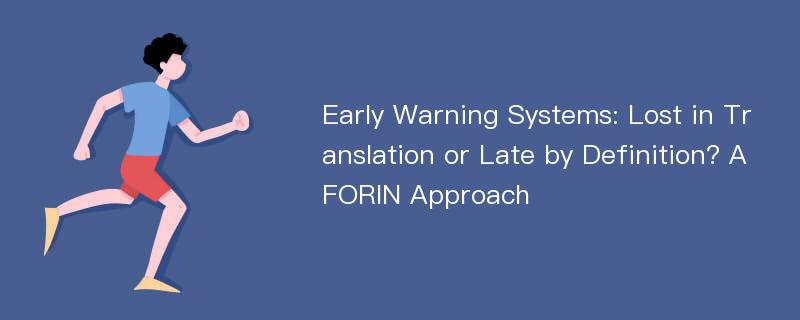
论文摘要
Early warning systems(EWSs) are widely considered to be one of the most important mechanisms to prevent disasters around the globe. But as disasters continue to affect countries where EWSs have already been implemented, the striking disaster consequences have led us to reflect on the focus, architecture, and function of the warning systems. Since the 2004 Indian Ocean tsunami there has been a rapid rise in the promotion and use of EWSs to minimize disaster losses and damage. However,few researchers have addressed the question of their acceptability as an adaptive measure to the existing exposure conditions. EWSs are far more linked to emergency response and humanitarian crises and accepted technological interventions as solutions than they are to explicitly advance integrated analysis, disaster risk reduction, and policy making. A major flaw of EWSs is that the term‘‘early’’ has been essentially used in reference to the speed of hazard onset, founded on a physicalist perspective that has encouraged a considerable dependence on technology.In this article we address the need for a clear understanding of the root causes and risk drivers of disaster risk creation,as advanced in the FORIN(forensic investigation of disasters) approach, as a prerequisite for the development of more articulated EWSs that could contribute to disaster risk reduction through policy making and practice, based on integrated and transdisciplinary management, in the interest of sustainable development, and human welfare and well-being.
论文目录
文章来源
类型: 期刊论文
作者: Irasema Alcántara-Ayala,Anthony Oliver-Smith
来源: International Journal of Disaster Risk Science 2019年03期
年度: 2019
分类: 工程科技Ⅰ辑
专业: 安全科学与灾害防治
单位: Institute of Geography, National Autonomous University of Mexico (UNAM),University of Florida
基金: the PASPA-DGAPA,UNAM program (Support Program for the Improvement of Academic Personnel of the UNAM) for supporting this research
分类号: X4
页码: 317-331
总页数: 15
文件大小: 2394K
下载量: 14
相关论文文献
- [1].Integrated Disaster Prevention and Reduction for Areas along the Belt and Road during the 14th Five-Year Plan Period: Global Disaster Reduction and Key Issues for Major Areas[J]. Asian Agricultural Research 2019(11)
- [2].Challenges with Disaster Mortality Data and Measuring Progress Towards the Implementation of the Sendai Framework[J]. International Journal of Disaster Risk Science 2019(04)
- [3].Disaster Knowledge Gaps: Exploring the Interface Between Science and Policy for Disaster Risk Reduction in Europe[J]. International Journal of Disaster Risk Science 2020(01)
- [4].Disaster is heartless, but everyone has love[J]. 中国研究型医院 2020(01)
- [5].The Sendai Framework for Disaster Risk Reduction at Five:Lessons from the 2011 Great East Japan Earthquake and Tsunami[J]. International Journal of Disaster Risk Science 2020(02)
- [6].Remembering,Forgetting,and Absencing Disasters in the Post-disaster Recovery Process[J]. International Journal of Disaster Risk Science 2020(03)
- [7].Sendai Five Years on: Reflections on the Role of International Law in the Creation and Reduction of Disaster Risk[J]. International Journal of Disaster Risk Science 2020(02)
- [8].Disaster Risk Science: A Geographical Perspective and a Research Framework[J]. International Journal of Disaster Risk Science 2020(04)
- [9].Fuzzy Boundaries Between Post-Disaster Phases: The Case of L'Aquila, Italy[J]. International Journal of Disaster Risk Science 2016(03)
- [10].Research progress in disaster nursing competency framework of nurses in China[J]. Chinese Nursing Research 2016(04)
- [11].Healthcare Services Demand in Post-disaster Settings:The 2014 Earthquake in Ludian County,Yunnan Province,China[J]. International Journal of Disaster Risk Science 2016(04)
- [12].Health and Risks:Integrating Health into Disaster Risk Reduction,Risk Communication,and Building Resilient Communities[J]. International Journal of Disaster Risk Science 2017(02)
- [13].A Systematic Study of Disaster Risk in Brunei Darussalam and Options for Vulnerability-Based Disaster Risk Reduction[J]. International Journal of Disaster Risk Science 2017(02)
- [14].Protecting People from Natural Disasters[J]. China Today 2017(06)
- [15].An Emergent Framework of Disaster Risk Governance towards Innovating Coping Capability for Reducing Disaster Risks in Local Communities[J]. International Journal of Disaster Risk Science 2011(02)
- [16].International Journal of Disaster Risk Science Instructions for Authors[J]. International Journal of Disaster Risk Science 2011(02)
- [17].Disaster Preparedness:Looking through the Lens of Hospitals in Japan[J]. International Journal of Disaster Risk Science 2013(02)
- [18].Implementation of Disaster Reduction Measures and Enhancement of Integrated Risk Governance in China[J]. International Journal of Disaster Risk Science 2013(02)
- [19].International Journal of Disaster Risk Science Instructions for Authors[J]. International Journal of Disaster Risk Science 2013(02)
- [20].Urban Resilience in Post-Disaster Reconstruction: Towards a Resilient Development in Sichuan,China[J]. International Journal of Disaster Risk Science 2012(01)
- [21].Towards a Policy that Supports People-Centered Housing Recovery——Learning from Housing Reconstruction after the Hanshin-Awaji Earthquake in Kobe,Japan[J]. International Journal of Disaster Risk Science 2012(01)
- [22].International Journal of Disaster Risk Science Instructions for Authors[J]. International Journal of Disaster Risk Science 2012(01)
- [23].Community Disaster Management Assets:A Case Study of the Farm Community in Sussex County,Delaware[J]. International Journal of Disaster Risk Science 2013(01)
- [24].International Journal of Disaster Risk Science Instructions for Authors[J]. International Journal of Disaster Risk Science 2013(01)
- [25].Lessons from International Students' Reaction to the 2011 Great East Japan Earthquake:The Case of the School of Engineering at Tohoku University[J]. International Journal of Disaster Risk Science 2013(03)
- [26].International Journal of Disaster Risk Science Instructions for Authors[J]. International Journal of Disaster Risk Science 2013(03)
- [27].International Journal of Disaster Risk Science Instructions for Authors[J]. International Journal of Disaster Risk Science 2014(04)
- [28].International Journal of Disaster Risk Science[J]. International Journal of Disaster Risk Science 2014(01)
- [29].Near-Real-Time Analysis of Publicly Communicated Disaster Response Information[J]. International Journal of Disaster Risk Science 2014(03)
- [30].Haiti 2010 Earthquake——How to Explain Such Huge Losses?[J]. International Journal of Disaster Risk Science 2011(01)
